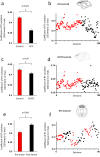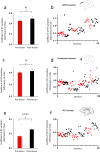Mapping causal links between prefrontal cortical regions and intra-individual behavioral variability
- PMID: 38168052
- PMCID: PMC10762061
- DOI: 10.1038/s41467-023-44341-5
Mapping causal links between prefrontal cortical regions and intra-individual behavioral variability
Abstract
Intra-individual behavioral variability is significantly heightened by aging or neuropsychological disorders, however it is unknown which brain regions are causally linked to such variabilities. We examine response time (RT) variability in 21 macaque monkeys performing a rule-guided decision-making task. In monkeys with selective-bilateral lesions in the anterior cingulate cortex (ACC) or in the dorsolateral prefrontal cortex, cognitive flexibility is impaired, but the RT variability is significantly diminished. Bilateral lesions within the frontopolar cortex or within the mid-dorsolateral prefrontal cortex, has no significant effect on cognitive flexibility or RT variability. In monkeys with lesions in the posterior cingulate cortex, the RT variability significantly increases without any deficit in cognitive flexibility. The effect of lesions in the orbitofrontal cortex (OFC) is unique in that it leads to deficits in cognitive flexibility and a significant increase in RT variability. Our findings indicate remarkable dissociations in contribution of frontal cortical regions to behavioral variability. They suggest that the altered variability in OFC-lesioned monkeys is related to deficits in assessing and accumulating evidence to inform a rule-guided decision, whereas in ACC-lesioned monkeys it results from a non-adaptive decrease in decision threshold and consequently immature impulsive responses.
© 2024. The Author(s).
Conflict of interest statement
The authors declare no competing interests.
Figures







Similar articles
-
Dissociable components of rule-guided behavior depend on distinct medial and prefrontal regions.Science. 2009 Jul 3;325(5936):52-8. doi: 10.1126/science.1172377. Science. 2009. PMID: 19574382
-
Aspiration removal of orbitofrontal cortex disrupts cholinergic fibers of passage to anterior cingulate cortex in rhesus macaques.Brain Struct Funct. 2024 May;229(4):1011-1019. doi: 10.1007/s00429-024-02776-6. Epub 2024 Mar 19. Brain Struct Funct. 2024. PMID: 38502331 Free PMC article.
-
The essential role of primate orbitofrontal cortex in conflict-induced executive control adjustment.J Neurosci. 2014 Aug 13;34(33):11016-31. doi: 10.1523/JNEUROSCI.1637-14.2014. J Neurosci. 2014. PMID: 25122901 Free PMC article.
-
Medial and orbital frontal cortex in decision-making and flexible behavior.Neuron. 2022 Sep 7;110(17):2743-2770. doi: 10.1016/j.neuron.2022.05.022. Epub 2022 Jun 14. Neuron. 2022. PMID: 35705077 Review.
-
Executive control fluctuations underlie behavioral variability in anthropoids.Trends Cogn Sci. 2025 Apr;29(4):331-343. doi: 10.1016/j.tics.2024.10.012. Epub 2024 Nov 18. Trends Cogn Sci. 2025. PMID: 39562262 Review.
Cited by
-
The Dorsolateral Prefrontal Cortex: A High-level Hub for Allostatic Cardiovascular Control.Curr Neuropharmacol. 2025;23(9):1036-1046. doi: 10.2174/011570159X340612241121072233. Curr Neuropharmacol. 2025. PMID: 39817396 Free PMC article. Review.
-
Perceptual Decision Efficiency Is Modifiable and Associated with Decreased Musculoskeletal Injury Risk Among Female College Soccer Players.Brain Sci. 2025 Jul 4;15(7):721. doi: 10.3390/brainsci15070721. Brain Sci. 2025. PMID: 40722312 Free PMC article.
-
Disentangling sources of variability in decision-making.Nat Rev Neurosci. 2025 May;26(5):247-262. doi: 10.1038/s41583-025-00916-3. Epub 2025 Mar 20. Nat Rev Neurosci. 2025. PMID: 40114010 Review.
-
Dissociating Frontal Lobe Lesion Induced Deficits in Rule Value Learning Using Reinforcement Learning Models and a WCST Analog.eNeuro. 2025 May 20;12(5):ENEURO.0117-25.2025. doi: 10.1523/ENEURO.0117-25.2025. Print 2025 May. eNeuro. 2025. PMID: 40393730 Free PMC article.
References
Publication types
MeSH terms
Grants and funding
LinkOut - more resources
Full Text Sources

